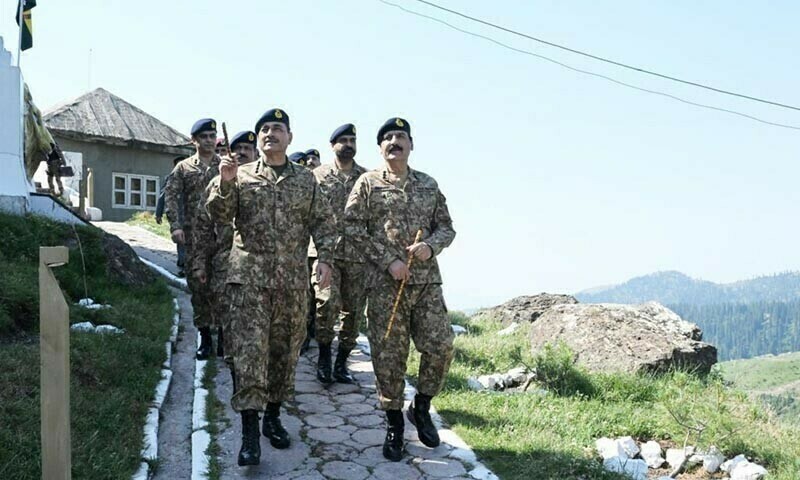
• DGMOs from both sides hold ‘initial round’ of talks to reinforce truce
• Dar says second round to follow within two days
• COAS calls conflict ‘defining chapter in the country’s military history’ as ISPR rejects reports of ceasefire breach
ISLAMABAD: Pakistani and Indian senior military officials on Monday agreed to uphold the ceasefire reached last week and reduce troop deployments along the international border, following days of hostilities between the two countries that had raised fears of a wider conflict.
The directors general of military operations (DGMOs) from both countries held a scheduled conversation at 4:30pm that lasted about 45 minutes. The discussion was originally scheduled for noon, but was postponed till afternoon — the delay was attributed by some sources to a difference over the agenda of the meeting.
The two officers — Pakistan’s Maj Gen Kashif Abdullah and India’s Lt Gen Rajiv Ghai — discussed measures to reinforce their mutual commitment not to fire or engage in any aggressive or inimical actions, according to Indian authorities. There was no official statement released by the Pakistan Army regarding the meeting.
In addition to reaffirming the ceasefire, the two sides reportedly agreed to pursue immediate steps to reduce troop presence along the borders and forward areas, which is seen as a significant move amid fragile calm after a four-day flare-up from May 7 to May 10.
Pakistani officials described the conversation as the initial round of talks after the ceasefire took effect. Foreign Minister Ishaq Dar said that the DGMOs are expected to have another round of talks within 48 hours for further discussions.
In peacetime, Pakistan and India typically station border security forces — the Pakistan Rangers and India’s Border Security Force, respectively — along the international border, while regular army troops remain in nearby cantonments for rapid deployment if needed. Under the existing terms of engagement, helicopters are restricted from flying within 1 kilometre of the border, and combat jets must remain at least 10 kilometres away.
During heightened tensions, both countries activate wartime formations, repositioning offensive and defensive units closer to the border. After escalation, defensive formations occupy positions on border, whereas offensive forces get into ‘concentration areas’ — usually behind the front lines, where units gather, assemble, and prepare before launching an attack or advancing, according to deployment contingencies. The same happened during this crisis. This understanding reached at the DGMOs interaction implies that some of the troops would move back to their peacetime locations. Pakistan’s defensive units are assigned specific sectors, while its offensive formations operate flexibly, without a pre-designated area of responsibility.
The latest contact between DGMOs comes after both countries agreed on May 10 to a “full and immediate ceasefire” following a sharp escalation that included drone and missile attacks, artillery fire, and airbase strikes. The violence was triggered by India’s May 7 aggression against Pakistan on the pretext of April 22 attack in Pahalgam, Indian-Occupied Kashmir. Pakistani armed military responded with ‘Operation Bunyanum Marsoos’.
Though the ceasefire was brokered through high-level US mediation, violations were reported just hours after the agreement took effect. Both sides blamed each other for the breaches and Monday’s meeting aimed to reinforce the fragile truce.
On Monday night, the army’s media wing responded to reports in the Indian media, saying that Pakistani forces were fully abiding by the ceasefire. It rejected Indian allegations regarding the violation of the ceasefire.
Indian Prime Minister Narendra Modi, in a televised speech, said India had “suspended retaliatory action” but warned that future conduct would be judged by Pakistan’s posture. “We will measure every step of Pakistan on the criterion that what sort of attitude Pakistan will adopt ahead,” he said.
In a detailed statement, Pakistan’s military described Operation Bunyan un Marsoos as a “textbook demonstration” of tri-services integration across land, air, sea, and cyber domains, delivering precision strikes against Indian military targets.
The operation employed long-range missiles, drones, and cyber warfare to hit 26 key installations in Indian-occupied Kashmir and mainland India, including air force bases, logistics hubs, command centres, and missile storage facilities, the Inter-Services Public Relations said in its statement. “Pakistan Armed Forces possess an ‘adequate’ suite of very sophisticated ‘niche military technologies’, and only a limited number and type were used with restraint in this conflict,” it maintained.
The ISPR emphasised that the operation was “precise, proportionate, and remarkably restrained,” targeting only those directly involved in attacks on Pakistani civilians.
“No hostile design can erode the determination of the Armed Forces of Pakistan,” army chief Gen Asim Munir said during a visit to injured personnel at CMH Rawalpindi.
“The resolute and unified response exhibited during Marka-i-Haq /Operation Bunyanum Marsoos, in concert with the steadfast support of the Pakistani people, constitutes a defining chapter in the country’s military history.”
Published in Dawn, May 13th, 2025





